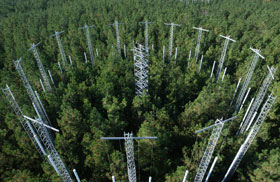Experiment Suggests Limitations to Carbon Dioxide 'Tree Banking'
Duke Forest trees receiving extra amounts of the gas for a decade added carbon to their tissues, but unevenly

While 10 years of bathing North Carolina pine tree stands with extra carbon dioxide did allow the trees to grow more tissue, only those pines receiving the most water and nutrients were able to store significant amounts of carbon that could offset the effects of global warming, scientists told a national meeting of the Ecological Society of America (ESA).
These results from the decade-long Free Air Carbon Enrichment (FACE) experiment in a Duke University forest suggest that proposals to bank extra CO2 from human activities in such trees may depend on the vagaries of the weather and large scale forest fertilization efforts, said Ram Oren, the FACE project director.
"If water availability decreases to plants at the same time that carbon dioxide increases, then we might not have a net gain in carbon sequestration," said Oren, a professor of ecology at Duke's Nicholas School of the Environment and Earth Sciences.
"In order to actually have an effect on the atmospheric concentration of CO2, the results suggest a future need to fertilize vast areas," Oren added. "And the impact on water quality of fertilizing large areas will be intolerable to society. Water is already a scarce resource. "
In a presentation delivered on Tuesday, Aug. 7 by Heather McCarthy, Oren's former graduate student, eight scientists working at the FACE site reported on the daily administrations of 1 1/2 times today's CO2 levels and how it has changed carbon accumulations in plants growing there.
The Department of Energy-funded FACE site consists of four forest plots receiving extra CO2 from computer-controlled valves mounted on rings of towers, and four other matched plots receiving no extra gas.
Trees in the loblolly pine-dominated forest plots that were treated produced about 20 percent more biomass on average, the researchers found. But since the amounts of available water and nitrogen nutrients varied substantially from plot to plot, using averages could be misleading.
"In some areas, the growth is maybe 5 or 10 percent more, and in other areas it's 40 percent more," Oren said. "So in sites that are poor in nutrients and water we see very little response. In sites that are rich in both we see a large response."
The researchers found that extra carbon dioxide had no effect on what foresters call "self thinning" -- the tendency of less-successful trees to die off as the most-successful grow bigger.
"We didn't find that elevated CO2 caused any deviation from this standard relationship," said McCarthy, now a postdoctoral fellow at the University of California, Irvine.
Also unchanged by the CO2 enrichment were the proportions of carbon atoms that found their way to various components of plant systems -- wood, leaves, roots and underlying soil. Only a few of those components will store carbon over time, noted Oren and McCarthy.
"Carbon that's in foliage is going to last a lot shorter time than carbon in the wood, because leaves quickly decay," McCarthy said. "So elevated CO2 could significantly increase the production of foliage but this would lead to only a very small increase in ecosystem carbon storage."
Other FACE researchers contributing to the ESA report were Kurt Johnsen of the U.S. Department of Agriculture's Forest Service, Adrien Finzi of Boston University, Seth Pritchard of the University of Charleston, Robert Jackson and Charles Cook of Duke and Kathleen Treseder of the University of California, Irvine.